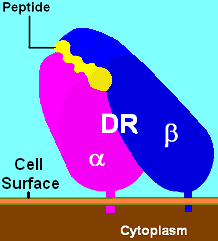Biology:HLA-DR53

| ||
major histocompatibility complex, class II, DR53
| ||
| Haplotypes | DRA*01:DRB4*0101 DRA*01:DRB4*0102 DRA*01:DRB4*0103 DRA*01:DRB4*0104 | |
| Structure (See HLA-DR) | ||
| Identifiers | alpha *0101
| |
| Symbol(s) | HLA-DRA[yes|permanent dead link|dead link}}] | |
| EBI-HLA | DRA*0101 | |
| Identifiers | beta 4 *0101 *0102 *0103 *0104
| |
| Symbol(s) | HLA-DRB4[yes|permanent dead link|dead link}}] | |
| EBI-HLA | DRB4*0101 | |
| EBI-HLA | DRB4*0102 | |
| EBI-HLA | DRB4*0103 | |
| EBI-HLA | DRB4*0104 | |
| Shared data | ||
| Locus | chr.6 6p21.31 | |
HLA-DR53 is an HLA-DR serotype that recognizes gene products of HLA-DRB4 locus. There are 13 alleles at this locus that encode 7 proteins.
DRB3, DRB4, and DRB5 are minor DR beta encoding loci, they have been recognized as having distinct evolution.[1] and the DRB4 locus presence is linked to HLA-DR7 seropositivity. The DRB4*locus was apparently duplicated from an ancestor of the DRB1-DRB4 common locus around 5 million years ago.[2]
DRB4 locus is only apparent in a small subset of DQ haplotypes, and most individuals lack DRB4. In addition the level of normal expression is 8 fold lower than the DRB1 in cells which can express both.[3] and lowered because of both transcriptional and post-transcriptional regulation.[4]
Alleles
| DRB4* | DR53 | ? | Sample |
| allele | % | % | size (N) |
| 0101 | 95 | 38 | |
| 0103 | 89 | 49 |
DR53 reactive alleles: DRB4*0101, *0103
Unknown reactivity: *0102, *0104 to *0107
Null alleles: *0101102N, *01030102N, *0201N, *0301N
Associated diseases
DRB4*01 is positively associated with Erythema multiforme,[6] Crohn's disease,[7] myasthenia gravis,[8] rheumatoid arthritis[9] Hashimoto's thyroiditis,[10] vitiligo,[11] primary biliary cirrhosis,[12] clozapine-induced agranulocytosis,[13] Vogt–Koyanagi–Harada disease,[14]
HLA-DRB1 linkage
HLA-DR53 serotypes (HLA-DRB4) is linked to the following HLADR serotypes (HLA-DRB1) allele groups:
HLA-DR4 - DRB1*04
HLA-DR7 - DRB1*07
HLA-DR9 - DRB1*09
References
- ↑ "Structural comparison of the genes of two HLA-DR supertypic groups: the loci encoding DRw52 and DRw53 are not truly allelic". Immunogenetics 25 (6): 397–402. 1987. doi:10.1007/BF00396106. PMID 3596674.
- ↑ "Genetic diversity at class II DRB loci of the primate MHC". J. Immunol. 146 (12): 4368–76. 1991. doi:10.4049/jimmunol.146.12.4368. PMID 2040804.
- ↑ "HLA-DRB1 and -DRB4 genes are differentially regulated at the transcriptional level". J. Immunol. 143 (9): 3081–6. 1989. doi:10.4049/jimmunol.143.9.3081. PMID 2809218.
- ↑ "Differential expression of isomorphic HLA-DR beta genes is not a sole function of transcription". Hum. Immunol. 50 (2): 111–20. 1996. doi:10.1016/0198-8859(96)00154-1. PMID 8891734.
- ↑ derived from IMGT/HLA
- ↑ "Erythema multiforme is associated to HLA-Aw33 and DRw53". Tissue Antigens 32 (3): 170–5. 1988. doi:10.1111/j.1399-0039.1988.tb01654.x. PMID 3217933.
- ↑ "Crohn's disease in the Japanese is associated with the HLA-DRw53". Exp. Clin. Immunogenet. 7 (2): 101–8. 1990. PMID 2322470.
- ↑ "HLA class II antigens and DNA restriction fragment length polymorphism in myasthenia gravis in Japan". Ann. Neurol. 29 (2): 168–74. 1991. doi:10.1002/ana.410290209. PMID 1672809.
- ↑ "Immunogenetics of rheumatoid arthritis and primary Sjögren's syndrome: DNA polymorphism of HLA class II genes". Dis. Markers 9 (5): 289–96. 1991. PMID 1686751.
- ↑ "Interactions of HLA-DRB4 and CTLA-4 genes influence thyroid function in Hashimoto's thyroiditis in Japanese population.". J Endocrinol Invest 26 (12): 1208–12. 2003. doi:10.1007/bf03349159. PMID 15055474.
- ↑ "Linkage and association of HLA class II genes with vitiligo in a Dutch population.". Br J Dermatol 145 (1): 90–4. 2001. doi:10.1046/j.1365-2133.2001.04288.x. PMID 11453913.
- ↑ "HLA DRB4 0101-restricted immunodominant T cell autoepitope of pyruvate dehydrogenase complex in primary biliary cirrhosis: evidence of molecular mimicry in human autoimmune diseases.". J Exp Med 181 (5): 1835–45. 1995. doi:10.1084/jem.181.5.1835. PMID 7536796.
- ↑ "The major histocompatibility complex region marked by HSP70-1 and HSP70-2 variants is associated with clozapine-induced agranulocytosis in two different ethnic groups.". Blood 86 (10): 3835–40. 1995. doi:10.1182/blood.V86.10.3835.bloodjournal86103835. PMID 7579351.
- ↑ "Tyrosinase epitope recognized by an HLA-DR-restricted T-cell line from a Vogt-Koyanagi-Harada disease patient.". Immunogenetics 47 (5): 398–403. 1998. doi:10.1007/s002510050375. PMID 9510558.
 |

